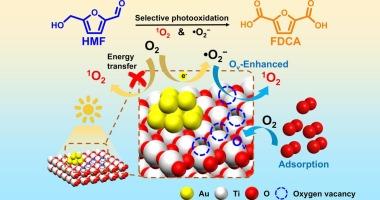Oxygen vacancies modulate reactive oxygen species for high-efficiency photocatalytic synthesis of 2,5-furandicarboxylic acid
IF 6.5
1区 化学
Q2 CHEMISTRY, PHYSICAL
引用次数: 0
Abstract
The selective photocatalytic conversion of 5-hydroxymethylfurfural (HMF) to 2,5-furandicarboxylic acid (FDCA) represents a promising approach to tackle increasing carbon management and climate challenges, but an insurmountable challenge lies in achieving efficient conversion at high substrate concentrations. Herein, Au/TiO2 catalysts with tunable oxygen vacancy (Ov) concentrations have been successfully prepared through adjusting the calcination atmospheres (air or H2), and serve as a platform to elucidate the critical role of Ov in selective HMF photo-oxidation. Specifically, thermal treatment under H2 atmosphere induces the escape of oxygen atoms from the TiO2 crystal structure, generating beneficial Ov defects that substantially enhance photocatalytic performance. Notably, the Ov-rich Au/TiO2-H2 catalyst demonstrates remarkably enhanced photocatalytic performance under challenging 500 mM HMF substrate concentration — achieving an exceptional FDCA yield of 97.0 % after 20 h of visible-light irradiation. Combined characterizations and experiments demonstrate the paramount role of 1O2 in hydroxyl group oxidation (rate-limiting phase). Besides, it has been conclusively demonstrated that Ov sites fulfill a dual-purpose catalytic function in 1O2 generation: facilitating the separation and migration of photo-induced charge carriers by functioning as electron trapping centers, while simultaneously facilitating the conversion of O2 molecules to generate reactive oxidative intermediates. The significance of this investigation extends beyond merely advancing our mechanistic comprehension of defect-mediated photocatalysis—it presents a viable methodology for the rational construction of high-performance catalytic materials tailored for photochemical selective oxidation transformations.

氧空位调节活性氧在高效光催化合成2,5-呋喃二羧酸中的作用
5-羟甲基糠醛(HMF)选择性光催化转化为2,5-呋喃二羧酸(FDCA)是解决日益增加的碳管理和气候挑战的一种有前途的方法,但难以克服的挑战在于在高底物浓度下实现高效转化。本文通过调整煅烧气氛(空气或H2),成功制备了氧空位(Ov)浓度可调的Au/TiO2催化剂,并为阐明Ov在选择性HMF光氧化中的关键作用提供了一个平台。具体来说,H2气氛下的热处理诱导了TiO2晶体结构中氧原子的逸出,产生了有益的Ov缺陷,从而大大提高了光催化性能。值得注意的是,富ov的Au/TiO2-H2催化剂在500 mM HMF底物浓度下表现出显著增强的光催化性能,在可见光照射20 h后,FDCA产率达到97.0 %。综合表征和实验证明了氧在羟基氧化(限速相)中的重要作用。此外,已经有结论证明Ov位点在1O2生成中具有双重催化功能:作为电子捕获中心促进光诱导载流子的分离和迁移,同时促进O2分子转化生成活性氧化中间体。这项研究的意义不仅仅是促进了我们对缺陷介导的光催化的机理理解,它为合理构建适合光化学选择性氧化转化的高性能催化材料提供了一种可行的方法。
本文章由计算机程序翻译,如有差异,请以英文原文为准。
求助全文
约1分钟内获得全文
求助全文
来源期刊

Journal of Catalysis
工程技术-工程:化工
CiteScore
12.30
自引率
5.50%
发文量
447
审稿时长
31 days
期刊介绍:
The Journal of Catalysis publishes scholarly articles on both heterogeneous and homogeneous catalysis, covering a wide range of chemical transformations. These include various types of catalysis, such as those mediated by photons, plasmons, and electrons. The focus of the studies is to understand the relationship between catalytic function and the underlying chemical properties of surfaces and metal complexes.
The articles in the journal offer innovative concepts and explore the synthesis and kinetics of inorganic solids and homogeneous complexes. Furthermore, they discuss spectroscopic techniques for characterizing catalysts, investigate the interaction of probes and reacting species with catalysts, and employ theoretical methods.
The research presented in the journal should have direct relevance to the field of catalytic processes, addressing either fundamental aspects or applications of catalysis.
 求助内容:
求助内容: 应助结果提醒方式:
应助结果提醒方式:


